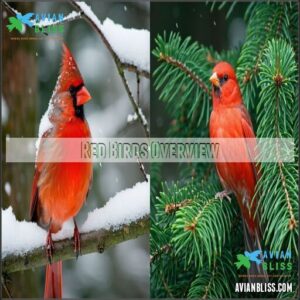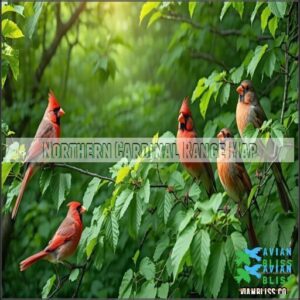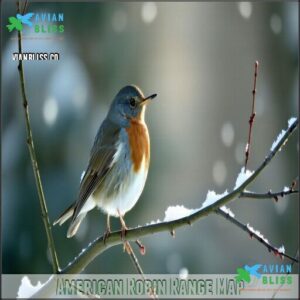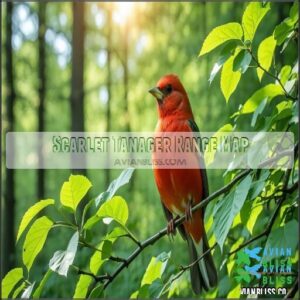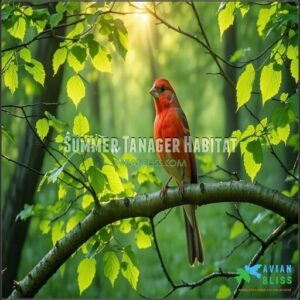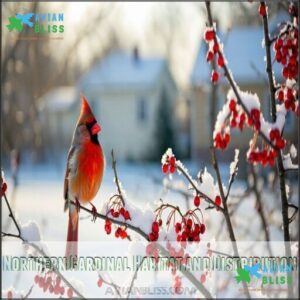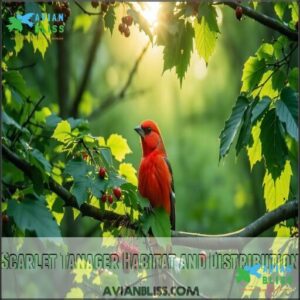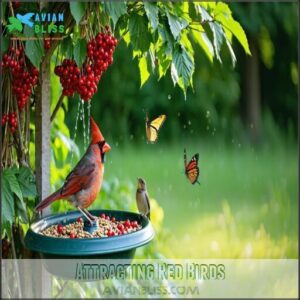This site is supported by our readers. We may earn a commission, at no cost to you, if you purchase through links.

The Northern Cardinal, with its bright red feathers and cheery song, is a year-round resident and a favorite at backyard feeders.
During summer, the Scarlet Tanager and Summer Tanager bring fiery hues to wooded areas, often hiding high in the trees.
The American Robin, though known for its rusty chest, flashes some red, too, as it hops across lawns in search of worms.
Even the House Finch, with its reddish tints, adds charm to urban spaces.
Keep an eye out—they’re nature’s little bursts of joy and can be seen in various locations, including backyard feeders and wooded areas, making them a favorite among bird watchers.
Table Of Contents
- Key Takeaways
- Red Birds Overview
- Illinois Bird Species
- Red Bird Habitats
- Attracting Red Birds
- Conservation Status
- Frequently Asked Questions (FAQs)
- What are the bright red birds in Illinois?
- What is the red bird that is not a cardinal?
- How rare are cardinals in Illinois?
- What is the old saying about seeing a cardinal?
- What is the bright red bird in Illinois?
- Are there other red birds besides cardinals?
- What kind of bird is red in Illinois?
- What’s the difference between a red bird and a cardinal?
- Do cardinals stay in Illinois all year round?
- Are cardinals and red birds the same?
- Conclusion
Key Takeaways
- You can spot vibrant red birds in Illinois like the Northern Cardinal, Scarlet Tanager, Summer Tanager, and House Finch in diverse habitats, from backyards to forests.
- Cardinals are year-round residents who love sunflower seeds and can be seen frequently at bird feeders, while tanagers typically visit during summer months.
- Attract red birds by providing native fruit-bearing plants, clean birdbaths, and feeders stocked with seeds like black oil sunflower seeds and millet.
- Habitat loss and climate change threaten some red bird populations, but you can help by reducing pesticides, planting native shrubs, and supporting bird conservation efforts.
Red Birds Overview
Illinois is home to a variety of red birds, ranging from the vibrant Northern Cardinal to the striking Scarlet Tanager.
You’ll find these colorful species in diverse habitats, each with unique traits that make them stand out, showcasing their unique traits.
Northern Cardinal Description
The Northern Cardinal is a true showstopper among Illinois birds. Its cardinal plumage—vivid red for males and warm brown with red hints for females—makes it easy to spot.
With vivid red plumage and striking charm, the Northern Cardinal is a stunning, year-round icon of Illinois’ birdlife.
Both sexes have a striking crest feature on their heads and a bold black mask detail that adds to their charm. At 8-9 inches, their size comparison rivals a small soda can.
You’ll often hear their cheerful whistles echoing through backyards.
Want to identify them?
- Look for their bold colors year-round.
- Spot their pointed crests.
- Listen for their iconic “what-cheer” song.
Scarlet Tanager Characteristics
The scarlet tanager is a showstopper among red birds in Illinois.
Its Male Plumage boasts vivid scarlet bodies with jet-black wings and tails, while the Female Appearance leans toward yellowish-green for subtle camouflage.
You might notice Molting Patterns, where males adopt olive hues in fall, resembling juveniles.
At 16–19 cm, their Size Comparison places them between a sparrow and a robin.
Found in Illinois’ treetops from May to September, they munch on insects, berries, and fruits, often serenading with their raspy, robin-like song.
Summer Tanager Identification
The Summer Tanager is a jewel among red bird species. Males flaunt stunning, all-over rose-red plumage that makes them easy to spot, especially during breeding season when their molting patterns bring out peak brilliance.
Females, on the other hand, show soft mustard-yellow or olive-green hues, offering a unique contrast to their male counterparts.
Immature tanagers often mimic females but display subtle molting patterns with patchy, spotted chests.
Need help with bird identification? Focus on these distinguishing features:
- No crest, unlike the similar scarlet tanager and Northern Cardinals.
- Solid red body for males, no black wings.
- Soft, robin-like "picky-tuck-tuck" calls in deciduous forests.
- Active in Illinois from May through August.
Add them to your summer bird identification guide!
American Robin Description
If you’re scouting backyard birds in Illinois, the American Robin is hard to miss.
As one of the most familiar red birds in Illinois, it sports a warm rusty-red breast, slate-gray back, and a dark head topped off with a broken white eye ring and yellowish bill—classic Robin markings.
You’ll spot these medium-sized Illinois birds, about 8-11 inches long with a 12-16.5 inch wingspan, hopping across lawns in their iconic hop-and-pause style.
Known for Robin vocalizations like their cheerful “cheerily, cheer-up” song, they’re found year-round.
Even juvenile robins are charming, with spotted breasts and less vibrant Robin plumage, adding character to your birdwatching experience.
House Finch Characteristics
If you’re admiring red birds in Illinois, the House Finch is a vibrant sight.
These compact finches measure 5-6 inches long with an 8-10 inch wingspan.
Males steal the show with rosy red heads and breasts, though their color intensity varies.
Females, on the other hand, show subtle brown streaks, blending into natural surroundings.
Recognizing them is easy with their conical seed-cracking bill and sociable nature.
House Finches are adaptable, often spotted year-round at feeders.
- Bright male coloration, perfect for spotting.
- Females have charming earthy tones.
- Chatter-filled vocalizations fill feeders.
- Thrives in urban and rural settings.
- Loves sunflower seeds!
Illinois Bird Species
You’ll find a surprising variety of red bird species across Illinois, from vibrant cardinals to striking tanagers.
Each one has unique features and habitats, making them exciting to spot if you know where to look, with vibrant cardinals being a notable example.
Northern Cardinal Range Map
The Northern Cardinal, a standout among Illinois birds, has firmly settled statewide.
Thanks to cardinal expansion and adaptability, these red birds thrive in urban parks, suburban backyards, and rural forests.
Unlike many Illinois bird species, they’re year-round residents, unaffected by seasonal shifts.
Mapping accuracy reveals their success amid habitat changes, showing stable populations despite urban sprawl.
For birdwatchers, spotting these vibrant icons is easy, as they’re among the most accessible and beloved red birds Illinois boasts.
House Finch Range Map
House finches, one of the most versatile red birds Illinois boasts, have an intriguing backstory.
These Illinois birds didn’t always call the state home—they’re the epitome of range expansion and urban adaptation. Originally from the western U.S., they made their way east due to:
- Release in New York during the 1940s.
- Rapid spread across the Midwest in following decades.
- Arrival in Illinois by the 1960s.
- Habitat overlap with native finch species.
- Adaptation to cities and climate change challenges.
House finches thrive statewide, gracing feeders and nests year-round. They’re known for their delightful bird songs around feeders.
American Robin Range Map
The American Robin stays year-round in Illinois, thriving in every corner—from city parks to countryside woods.
Its range map highlights impressive adaptability, making it a familiar face across the state. This species showcases resilience to climate change, though urban sprawl challenges its habitats.
Here’s a quick look at their range:
| Factor | Range Details | Insights |
|---|---|---|
| Seasonal Presence | Year-round | Always noticeable statewide |
| Habitat Variation | Urban and rural landscapes | Highly adaptable |
| Population Density | High | Flourishing numbers |
| Climate Impact | Minimal so far | Stable despite shifts |
| Red Bird Identification | Rusty red breast | Easy-to-spot features |
Listen for their cheerful songs—they’re nature’s morning alarm!
Scarlet Tanager Range Map
Scarlet Tanagers, one of Illinois’s most dazzling red bird species, are a treat for bird watching enthusiasts.
Their breeding distribution spans northern and central Illinois, primarily within lush deciduous forests. You’ll catch these vibrant beauties from late April to early October, marking their migration patterns.
However, habitat loss and climate change could reshape their range. Current data accuracy still holds, but come winter, they depart Illinois entirely, wintering in South American sanctuaries.
Summer Tanager Habitat
Let’s chat about Summer Tanagers, a stunning red bird species that love Illinois bird habitats.
These beauties thrive in open woodlands, especially oak and hickory forests with a medium forest canopy height. They prefer nesting locations along woodland edges and orchards, crafting shallow cup nests.
You’ll spot them in mixed pine-oak ecosystems, buzzing with insects—like a buffet for these birds. During summer, these tropical forest visitors brighten Illinois ecosystems, following their elevation preferences and food sources.
Keep an eye out—you might just spot one in your favorite woods, and enjoy the beauty of these open woodlands and Illinois ecosystems.
Red Bird Habitats
If you want to spot red birds in Illinois, you’ll need to know exactly where they live.
These vibrant species favor habitats like dense forests, open woodlands, and backyard feeders, each offering unique opportunities to observe their behavior.
Northern Cardinal Habitat and Distribution
In the context of cardinal habitats, these vibrant red birds are a year-round spectacle across Illinois.
Unlike many migratory species, cardinals stay put, even braving the state’s cold winters. They thrive in suburban neighborhoods, proving urban cardinals know how to make themselves at home.
You’ll often spot them in thickets, woodland edges, or backyard shrubs, adding a dash of crimson to everyday life.
Habitat loss can threaten Illinois bird species, but these adaptable backyard birds have a knack for thriving near humans.
Keep an eye out while enjoying parks or your own yard—they’re hard to miss, as they are vibrant red birds in a year-round spectacle.
House Finch Habitat and Distribution
House Finches are Illinois bird species that thrive in bustling neighborhoods and city parks, showcasing impressive Urban Adaptation. These red birds don’t mind the human touch, often making homes on ledges, shrubs, or evergreens.
Their Nesting Preferences include building cup-shaped nests in areas with scattered trees and food sources. Originally an Introduced Species, they’ve spread widely, adjusting to Regional Variations with incredible ease.
You’ll spot them year-round at feeders stocked with sunflower seeds, creating a high Population Density in backyards. They’re a favorite for Illinois bird identification, blending seamlessly into urban bird habitats and distribution.
American Robin Habitat and Distribution
Adaptability defines the American Robin, a standout among Illinois bird species.
These urban robins thrive in a wide range of environments, from suburban lawns to city parks and forest edges. You’ll often see them hopping across grassy spaces, hunting for worms or insects with their signature tilted-head pose—like feathered detectives on a case.
Robin nesting is equally versatile—tree branches, shrubs, or even ledges near buildings provide ideal spots. While some follow Robin migration patterns south for winter, others stay put, especially in urban areas where food is plentiful, defying climate impacts.
Their cheerful spring songs mark a seasonal shift, a soundtrack for Illinois bird habitats. Truly, they’re Illinois bird habitats’ multitasking marvel, showcasing their ability to thrive in various environments with versatile adaptations.
Scarlet Tanager Habitat and Distribution
During spring and summer, Scarlet Tanagers bring vibrant color to Illinois’s mature forests.
They thrive in dense, tall tree canopies—oak, maple, or mixed woods—providing perfect breeding territories. These birds avoid open edges, preferring interiors rich with insects and berries.
Like the scarlet tanager, several red birds thrive in other states. These birds avoid open edges, preferring interiors rich with insects and berries.
- Forest Preferences: Dense woodlands, tall trees, and seclusion.
- Breeding Territories: High treetops for safety from predators.
- Illinois Range: Statewide forests, though habitat loss challenges their presence in some areas.
For nature lovers, spotting one is a rewarding treasure!
Summer Tanager Habitat and Distribution
Summer Tanagers brighten Illinois landscapes from April to October, claiming their breeding grounds in open oak and hickory woodlands.
These bold insect hunters love the canopy structure, catching prey mid-flight. You might spot one in orchards, parks, or even along quiet roadsides.
Watch closely—these clever birds will smack a bee or wasp against a branch to remove the stinger.
Their range in Illinois bird habitats and ecosystems is influenced by forest preferences and elevation. Changing climates and shifting diets are already reshaping their Illinois migration and adaptability in bird distribution maps.
Attracting Red Birds
If you want to attract red birds in Illinois, you’ll need to focus on creating a welcoming habitat.
Providing food, water, and shelter suited to their needs can turn your yard into a bustling bird hotspot.
Food and Water Sources for Red Birds
If you’re hoping to attract red birds to your yard, it’s all about catering to their tastes. Each species has unique preferences, so variety is key.
Cardinals adore black oil sunflower seeds, while finches favor millet. Scarlet Tanagers? They’ll enthusiastically munch on insects and berries.
To create an inviting space, here’s what you can do:
- Add black oil sunflower seeds in feeders for cardinals.
- Offer smaller seeds like millet to please finches.
- Plant fruiting shrubs to provide natural forage for tanagers.
- Place a shallow bird bath to boost water availability year-round.
- Position feeders near trees, giving birds some cover as they feed.
Consider purchasing black oil seeds to support local businesses. With these tips, your yard will be buzzing with vibrant visitors and become a haven for wildlife, offering them natural forage and a shallow bird bath, making it an ideal spot for bird watching.
Shelter and Nesting Sites for Red Birds
Creating cozy nesting spaces for red birds in Illinois helps them thrive. Cardinals love evergreen shrubs, while woodpeckers prefer tree cavities.
Scatter brush piles or set nesting boxes 5–7 feet high to invite backyard birds. House finches favor dense bushes—add twigs, yarn, or pet hair for nesting flair! Thick vegetation or quiet rock crevices offer safe spots from predators. Cup nests offer flexibility and protection.
Got tanagers? Open areas with tall trees are ideal.
Here’s a quick guide to support bird nesting in Illinois:
| Bird | Preferred Nest | Season |
|---|---|---|
| Northern Cardinal | Shrubs/evergreens | Spring–Summer |
| Woodpecker | Tree cavities | Early Spring |
| House Finch | Dense bushes | Late Spring-Summer |
| Scarlet Tanager | Tall trees | Summer |
Bird Feeders and Bird Baths for Red Birds
Want to attract colorful visitors like the cardinal in Illinois? The right bird feeders and baths can make your yard a magnet for common red birds. Placement and consistency are key.
Set up platform feeders about 5–6 feet high, stocked with black oil sunflower seeds—the go-to snack for red birds. Regular cleaning matters too. Wash feeders weekly with a diluted bleach solution to keep everyone healthy. Many bird enthusiasts find elevated feeding stations particularly effective.
Bird baths are just as essential. Choose ones with shallow water (1–2 inches) and a rough bottom so birds can grip securely. Keep it clean and ice-free in winter when natural water sources freeze.
- Winter feeding is a lifesaver when food disappears.
- A variety of feeder types helps cater to different species.
- Bath placement near cover guarantees birds feel safe while hydrating.
Make small changes, and your yard becomes a hotspot for bird feeding joy!
Planting Native Fruit-Bearing Plants for Red Birds
It’s not just about feeders – native plant choices turn your yard into a bird paradise.
Berry size matters when attracting common red birds like the Northern Cardinal or Summer Tanager.
These Illinois bird species appreciate seasonal fruit availability and shelter.
To enhance your bird garden, consider exploring options for sourcing native plants.
Here’s a quick guide:
| Plant | Ideal Season | Bird Attraction |
|---|---|---|
| Elderberry | Summer, Fall | Cardinals, Robins |
| Serviceberry | Spring | Tanagers, Cardinals |
| Dogwood | Fall | Robins, Grosbeaks |
By planting for shelter and long-term sustainability, you’ll create a haven supporting bird diets and bird habitats in Illinois.
Conservation Status
You’ll want to understand how red bird populations in Illinois are faring, as some species face threats like habitat loss and climate change.
Conservation efforts, whether through habitat protection or public support, play a pivotal role in ensuring these birds continue to brighten our landscapes with their presence, which is why conservation efforts are crucial.
Northern Cardinal Conservation Status
How do Northern Cardinals stay so resilient in Illinois? It’s not just their charm — it’s a blend of adaptability and protection.
These bright red icons thrive thanks to steady population trends and minimal climate change impact. Here’s why the cardinal in Illinois remains a conservation success:
- Adapts well to urban environments.
- Benefits from strict wildlife laws.
- Nests successfully across diverse habitats.
- Gains from public awareness campaigns.
- Climate change hasn’t drastically impacted them yet.
Still, habitat conservation is key, and understanding these factors is crucial for the continued success of the Northern Cardinals, which is a conservation success due to their ability to thrive in various conditions.
Threats to Red Bird Populations
Amid Illinois’ natural beauty, red birds face notable challenges.
Habitat loss from sprawling developments shrinks forests where cardinal Illinois species thrive.
Scarlet Tanagers, sensitive to mature woodland loss, feel this pinch sharply.
Climate change further complicates migration, altering routines for birds like the American Robin.
Meanwhile, pesticide use slashes insect supplies, leaving once-reliable food sources scarce.
You mightn’t consider it, but even your windows pose a threat—thousands of Illinois bird populations perish annually in collisions.
Invasive species also compete for dwindling territory and food, making survival a tougher game.
By understanding these threats—from habitat loss to predation risks—you’re already taking the first step toward supporting Illinois bird conservation efforts in your community.
Conservation Efforts in Illinois
Protecting red birds in Illinois isn’t just for nature buffs—it’s something anyone can support. Illinois bird conservation initiatives focus on Habitat Preservation and helping species like the cardinal.
Protecting Illinois’ red birds starts with small actions, ensuring vibrant species like the cardinal thrive for future generations.
Bird conservation efforts across the state address issues like climate change and habitat loss. Regenerative agriculture promotes bird-friendly farming practices.
You can get involved in meaningful ways:
- Participate in Citizen Science through Chicago Wildlife Watch or similar programs.
- Support habitat restoration using native plants and reducing pesticides in your yard.
- Join Nesting Programs to provide safe spaces for birds like cardinals in Illinois.
- Collaborate with groups like the Illinois Audubon Society, which runs workshops on bird conservation in Illinois.
Together, we can guarantee Illinois’ birds thrive!
Protecting Red Bird Habitats
Saving Illinois red birds starts with thoughtful choices in your backyard.
Swap pesticides for natural solutions to minimize harm caused by pesticide use. Add native plants like shrubs and trees to provide nesting protection and food essential for Illinois bird conservation.
Advocate for limits on habitat loss and climate change impacts by supporting local habitat restoration projects.
Connecting fragmented woodlands strengthens Illinois bird habitats protection, giving birds like scarlet tanagers a better chance.
Even small changes create a ripple effect in bird conservation across Illinois, and supporting local projects can lead to significant positive impacts, making Illinois bird conservation and habitat restoration crucial for the well-being of these species.
Supporting Red Bird Conservation
Helping Illinois’ red birds thrive takes just a few small, meaningful steps.
By embracing conservation, you can make a big difference for species like the Northern Cardinal and Scarlet Tanager. Here’s how:
- Join citizen science projects like eBird to track Illinois bird species in Illinois and contribute valuable data.
- Reduce pesticides and support habitat restoration to create bird-friendly yards.
- Install bird-friendly windows to protect birds during migrations.
- Support local groups focused on Illinois bird conservation and education efforts.
Your actions safeguard Illinois red birds and their habitats for future generations.
Frequently Asked Questions (FAQs)
What are the bright red birds in Illinois?
Picture a vibrant splash of red darting through the trees—Illinois is home to stunning birds like the Northern Cardinal, Scarlet Tanager, and Summer Tanager.
These fiery beauties brighten forests, backyards, and even your morning!
What is the red bird that is not a cardinal?
The House Finch is a red bird that isn’t a cardinal.
Males sport a rosy-red head and chest, while females are streaky brown.
They’re commonly found near backyards, feeders, and urban spots across Illinois.
How rare are cardinals in Illinois?
Cardinals aren’t rare in Illinois—you’ll spot them year-round in woodlands, gardens, and even your backyard.
Males’ bright red feathers make them impossible to miss, while females blend in with their subtle reddish-brown tones.
What is the old saying about seeing a cardinal?
They say when you see a cardinal, it’s a visit from a loved one who’s passed on.
This vibrant bird’s appearance is a gentle reminder that their spirit is near, watching over you!
What is the bright red bird in Illinois?
The bright red bird you’re likely spotting in Illinois is the Northern Cardinal.
Male cardinals are a vivid red with a black face mask, making them impossible to miss, especially during snowy winters.
Are there other red birds besides cardinals?
Ever wondered if Illinois has more than just cardinals flying around?
Absolutely! Look for red birds like the Scarlet Tanager, Summer Tanager, and House Finch.
They’ll brighten your day with fiery feathers.
What kind of bird is red in Illinois?
In Illinois, you’ll spot vibrant red birds like Northern Cardinals, Scarlet Tanagers, and Summer Tanagers.
Males often steal the show with bold plumage, while females sport subtler hues, adding a splash of charm to forests and backyards.
What’s the difference between a red bird and a cardinal?
Think of all cardinals as red birds, but not all red birds as cardinals.
Cardinals are a specific species, bright red with a black face mask, while red birds can include many species.
Do cardinals stay in Illinois all year round?
Yes, cardinals stick around all year in Illinois, brightening up even the gloomiest winters.
They’re incredibly adaptable, nesting in backyards, woodlands, and parks.
Plus, they’re daily visitors to bird feeders, especially loving sunflower seeds!
Are cardinals and red birds the same?
Not all red birds are cardinals, but cardinals are one of the most recognizable red birds.
Their vibrant color makes them stand out, yet other species like Scarlet Tanagers and House Finches share the spotlight, with vibrant color being a key characteristic.
Conclusion
Ironically, spotting red birds in Illinois isn’t as rare as you might think—if you know where to look.
Whether it’s the feisty Northern Cardinal or the elusive Scarlet Tanager, these vibrant birds add color to your backyard or local forest.
Grab some binoculars, set up a feeder, or plant native shrubs to invite them closer.
It’s time to turn birdwatching into an adventure and marvel at nature’s crimson wonders right in your own state.
- https://www.museum.state.il.us/exhibits/symbols/bird.html
- https://dnr.illinois.gov/education/wildaboutpages/wildaboutbirds/wildaboutbirdscardinals/wabnortherncardinal.html
- https://www.birdwatchingacademy.com/backyard-birds-of-illinois/
- https://pasquesi.com/backyard-birds-of-illinois/
- https://www.allaboutbirds.org/guide/Northern_Cardinal/id

